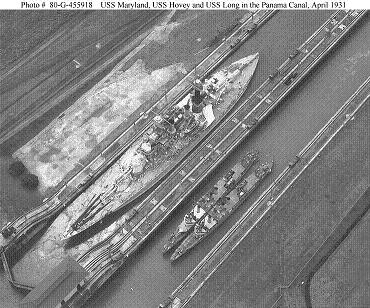![]() The Pacific War Online Encyclopedia
The Pacific War Online Encyclopedia
|
| Previous: Pan Wen-hua | Table of Contents | Next: Panay |

National
Archives #80-G-455918
The Panama Canal was probably the single most
important
waterway for the United States
during the Pacific War. It permitted the U.S. Navy to move ships from the Atlantic
to the Pacific and back relatively quickly. Without the Canal,
these ships
would have to make the much long journey through the Strait of Magellan at the southern tip of South America.
The French first attempted construction of a canal across the Isthmus of Panama starting in 1870, but were unsuccessful, largely because of the hazards of jungle construction. The United States picked up the effort in 1904, after supporting a revolution that detached Panama from Colombian political control and established a friendly local government. Work was finished in 1914, at the cost of $352 million dollars. Over 30,000 lives were lost between the French and American efforts. The final American success was possible only because of the groundbreaking work of Dr. Walter Reed, who proved the theory first proposed by Dr. Juan Finley in 1881 that the deadly yellow fever was mosquito-transmitted. A mosquito eradication campaign reduced yellow fever deaths dramatically and allowed the canal construction to move forward. The campaign also dramatically reduced the incidence of malaria, the other great jungle killer of Panama.
The canal is roughly 45 miles long, with three
pairs of locks at
each end
to raise ships to the level of Lake Gatun. Each lock chamber was
110 ' by 1000' (35.5m by 305m) and had gates 7' (2.1m) thick. Maximum draft was 40' (12.2m). The lock
chamber size long limited the size of warship the U.S. Navy was willing to
construct, though by 1942 Congress had authorized construction of Montana-class battleships that were too large to use the Canal. (As it turned out, the Montana program was canceled before any units were laid down.) The Pacific end of the Canal is
actually
slightly further east than the Atlantic end, so that ships transiting
the Canal
from the Atlantic to the Pacific travel south-southeast. Transit time
was typically eight to ten hours.
The Canal’s obvious strategic importance led the
United States to station considerable military forces in the Canal
Zone. The headquarters for the coastal artillery
batteries, which were of battleship caliber, was at Fort
Sherman west of the northern (Atlantic) entrance to the Canal. The less
extensive defenses on the Pacific side were centered at Fort Kobbe,
west of the southern (Pacific) entrance to the Canal and opposite
Panama City. Antiaircraft protection was provided by 88 Coast Artillery
Regiment from 20 August 1942 on. On 1 July 1940, 550 Infantry Airborne Battalion was activated at Howard Field near Fort Kobbe, where is was joined a few days later by 510 Parachute Battalion from Fort Benning. The two battalions had orders to be prepared to rapidly deploy to any Central American capital city in the event that pro-Axis elements attempted a coup d'etat.
The Japanese studied several plans for disabling the Canal, of which the least implausible was probably the construction of seaplane-carrying submarines from which a raid could be launched on the lock gates. However, given the U.S. fighter cover assigned to the Canal Zone, such a raid could only have been staged at night and would have required the most incredible luck to do significant damage.
References
The Pacific War Online Encyclopedia © 2006, 2008, 2012 by Kent G. Budge. Index